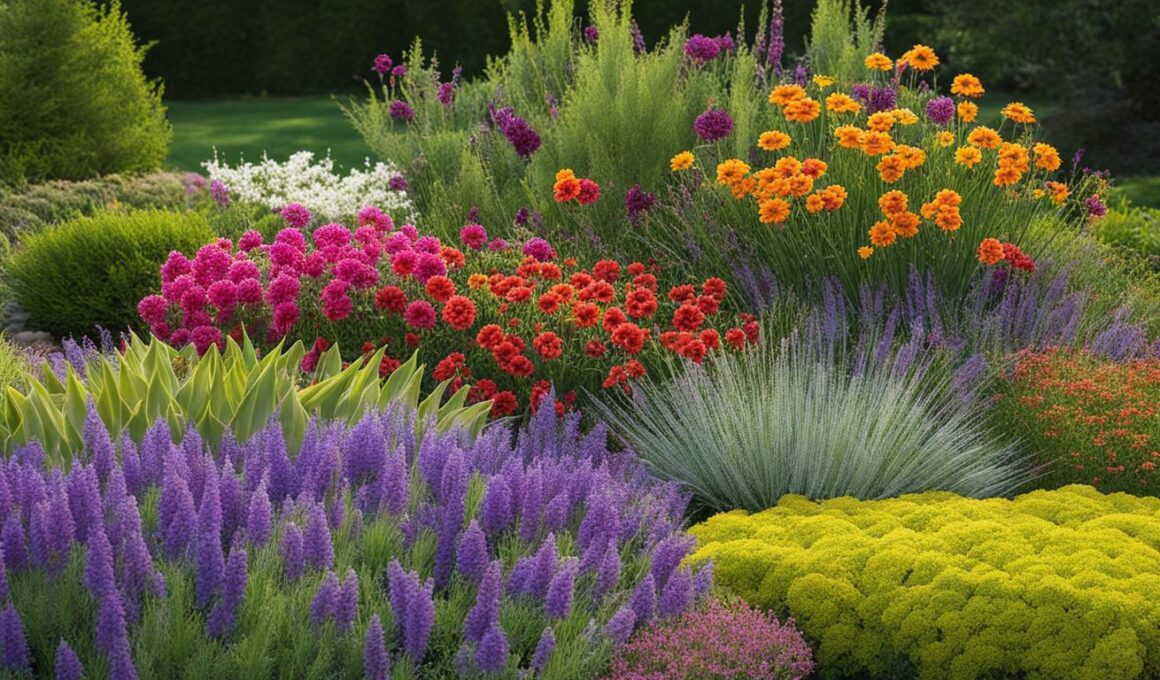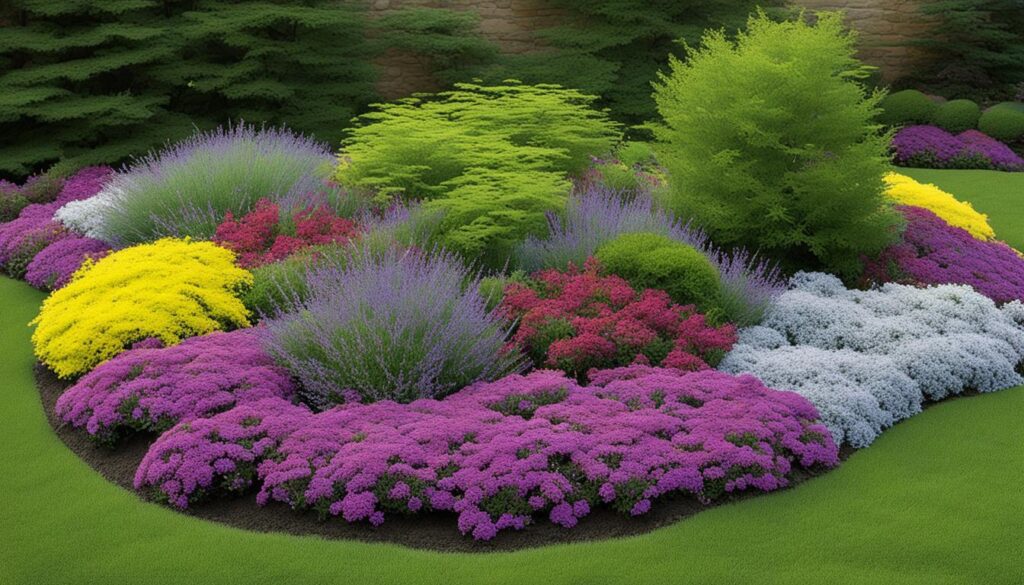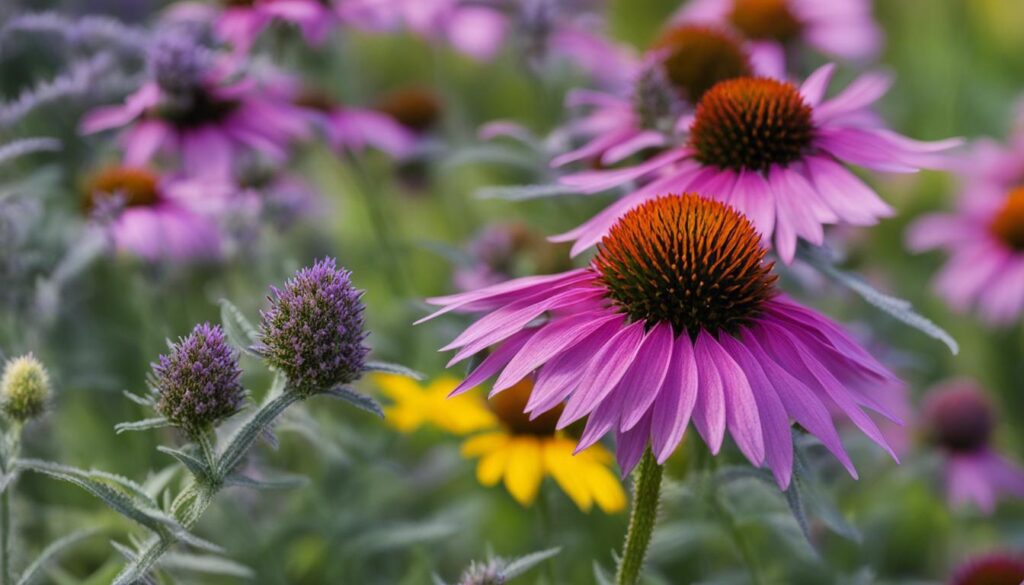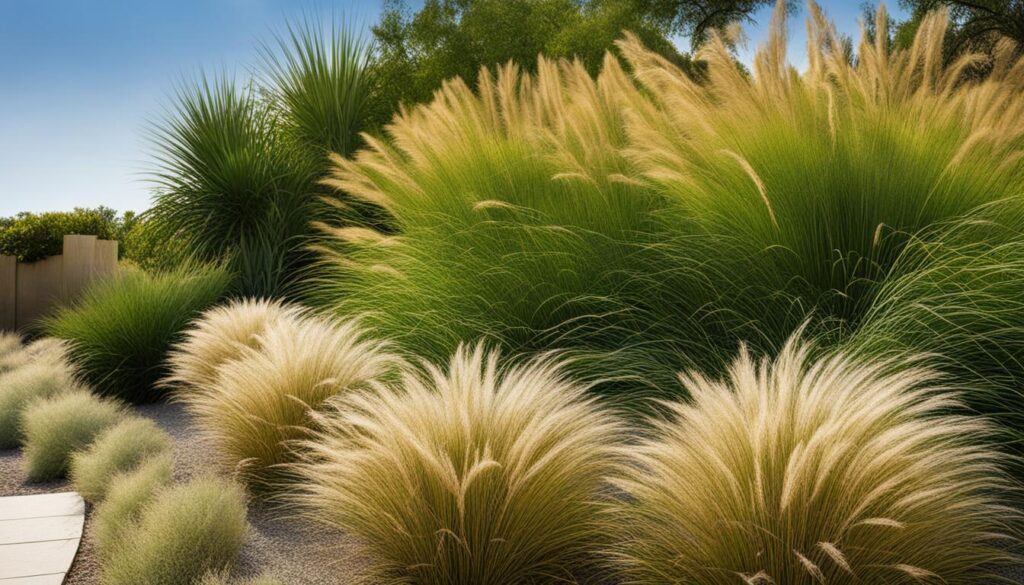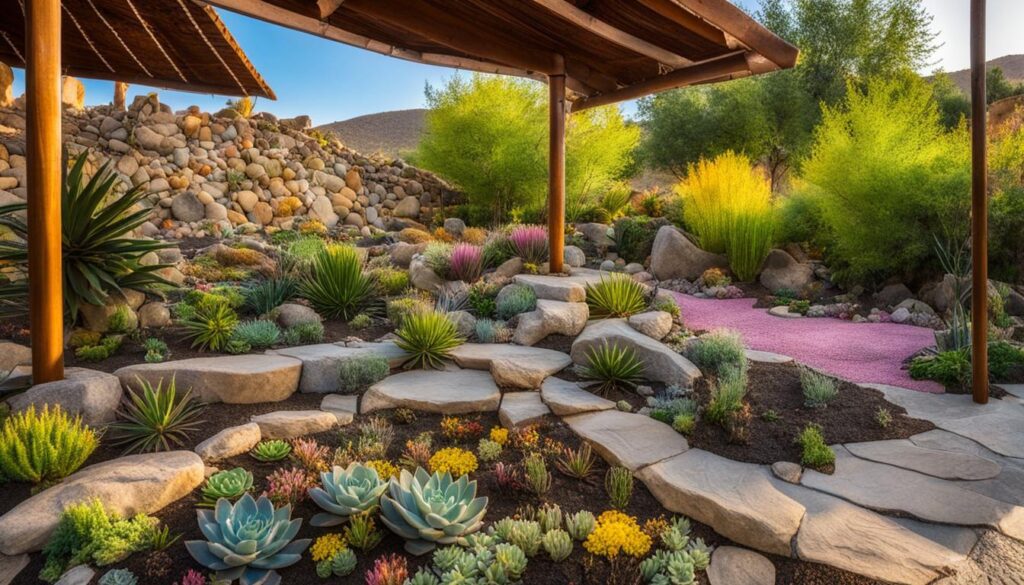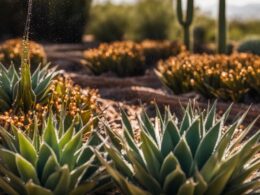Xeriscape gardening is a low-water technique that aims to reduce the need for irrigation. Contrary to popular belief, xeriscape gardens can be lush and vibrant, and there is a wide variety of plants that thrive in this type of environment. By following the principles of xeriscaping, such as planning in advance, limiting turfgrass, and choosing plants with lower water needs, you can create a stunning and water-efficient landscape.
Key Takeaways:
- Perennials are a great choice for xeriscape gardens due to their ability to thrive in low-water conditions.
- Planning and selecting plants with lower water needs are essential for the success of your xeriscape garden.
- Xeriscape gardens can be lush and vibrant with the right plant choices and landscaping techniques.
- By embracing xeriscape gardening, you can create a beautiful and sustainable landscape that conserves water and reduces maintenance needs.
- Start creating your own xeriscape garden today and enjoy the beauty it brings all season long.
Understanding Xeriscape Gardening and Its Benefits
Xeriscape gardening is a landscaping method that focuses on conserving water and reducing maintenance needs. It is particularly popular in areas prone to drought and water shortages. By using native plants and grouping them based on their water needs, xeriscape gardens can thrive with minimal irrigation. Some of the benefits of xeriscape gardening include reduced water usage, lower maintenance requirements, and the creation of habitats for local wildlife.
One of the key principles of xeriscape gardening is selecting plants that are well-suited to the local climate and soil conditions. Native plants are an excellent choice as they have adapted to the local environment and are more likely to thrive with less water. Grouping plants with similar water needs together also helps to maximize water efficiency in the garden.
“Xeriscape gardens are not only practical but also beautiful. By embracing this water-efficient landscaping approach, you can create a stunning outdoor space that requires less water for irrigation.”
In addition to reducing water usage, xeriscape gardens also have lower maintenance requirements compared to traditional gardens. With the use of drought-tolerant plants, there is less need for frequent watering and fertilizing. This not only saves time but also reduces the need for chemical inputs, making xeriscape gardening an eco-friendly choice.
Furthermore, xeriscape gardens play an important role in promoting biodiversity and creating habitats for local wildlife. By incorporating a variety of native plants and providing food and shelter, xeriscape gardens attract birds, butterflies, and beneficial insects. These creatures contribute to the overall health and balance of the ecosystem, making your garden a thriving hub of biodiversity.
Water Conservation Tips for Xeriscape Gardening:
- Water deeply and infrequently to encourage deep root growth.
- Use mulch to retain moisture and suppress weed growth.
- Consider installing a drip irrigation system for targeted watering.
- Capture and reuse rainwater for irrigation purposes.
- Choose plants with low water needs and drought tolerance.
By understanding the principles of xeriscape gardening and implementing water conservation strategies, you can create a beautiful and sustainable landscape that conserves water, reduces maintenance, and supports local biodiversity.
Ground Covers and Low-Lying Plants for Xeriscape Gardens
When creating a xeriscape garden, choosing the right ground covers and low-lying plants is essential. These plants not only add beauty and texture to your garden but also help conserve moisture in the soil and prevent weed growth. Here are some excellent options for ground covers and low-lying plants that thrive in xeriscape gardens:
Sedum rubrotinctum
This succulent plant, also known as Jelly Bean plant, features thick, fleshy leaves that turn vibrant red in full sun. It is drought-tolerant and requires minimal watering, making it an ideal choice for xeriscape gardens.
Pachysandra procumbens
Commonly known as Allegheny spurge, this evergreen ground cover is known for its beautiful purple flowers and glossy green leaves. It can tolerate a wide range of soil conditions and is an excellent choice for shady areas in a xeriscape garden.
Ophiopogon japonicus
Also called Mondo grass, this low-lying plant creates a lush carpet-like effect with its dense tufts of grass-like foliage. It is extremely low-maintenance and thrives in both full sun and partial shade.
Aloe aristata
This striking succulent, also known as Lace Aloe, features rosettes of fleshy, toothed leaves with white speckles. It is drought-tolerant and produces beautiful coral-orange flowers, adding a pop of color to your xeriscape garden.
By incorporating these ground covers and low-lying plants into your xeriscape garden, you can create a visually appealing and water-efficient landscape that thrives even in arid conditions. Their ability to conserve moisture and suppress weed growth will not only save you time and effort but also contribute to the overall sustainability of your garden.
Drought-Tolerant Flowers for Xeriscape Gardens
If you’re looking to add a burst of color to your xeriscape garden without compromising its water efficiency, consider incorporating drought-tolerant flowers. These hardy plants are well-suited to arid environments and require less water compared to traditional garden flowers. Not only will they thrive in your xeriscape garden, but they will also attract pollinators and create a vibrant and inviting atmosphere.
One stunning option is Erigeron karvinskianus, also known as Santa Barbara daisy. This low-growing perennial produces masses of delicate white flowers which gradually turn pink as they mature. It is a perfect choice for rock gardens or as ground cover in sunny areas. Another excellent choice is Euphorbia myrsinites, commonly known as myrtle spurge. With its unique blue-green foliage and vibrant yellow flowers, this plant adds a pop of color and texture to any xeriscape garden.
Sedum kamtschaticum, or Russian stonecrop, is another fantastic option for a drought-tolerant garden. Its succulent leaves and bright yellow flowers create a visually striking display, especially when planted en masse. Lastly, Callirhoe involucrata, or winecups, is a beautiful flowering perennial with deep magenta flowers that bloom from spring to fall. Its sprawling habit makes it a great addition to borders and rock gardens.
By incorporating these drought-tolerant flowers into your xeriscape garden, you can enjoy their beauty while conserving water. Remember to water them sparingly and provide well-draining soil to help them thrive in their arid environment. With these vibrant additions, your xeriscape garden will become a colorful oasis that will impress both you and your visitors.
Drought-Tolerant Shrubs for Xeriscape Gardens
When it comes to creating a stunning and water-efficient xeriscape garden, incorporating drought-tolerant shrubs is a fantastic choice. These hardy plants not only add structure and texture to your landscape but also require minimal watering, making them ideal for xeriscape gardening. Here are some exceptional drought-tolerant shrubs that will thrive in your xeriscape garden:
- Salvia sonomensis: Also known as Creeping Sage, this shrub features fragrant gray-green foliage and beautiful purple flowers. It is highly drought-tolerant and attracts pollinators, making it a wonderful addition to any xeriscape garden.
- Artemisia schmidtiana: Commonly referred to as Silver Mound, this shrub has delicate silver-gray foliage that adds a soft and elegant touch to your garden. It thrives in dry conditions and requires minimal watering.
- Juniperus conferta: With its low-growing and spreading form, this shrub, also known as Shore Juniper, is an excellent choice for ground cover in xeriscape gardens. It is highly adaptable to various soil conditions and drought-tolerant.
- Gaillardia: Also called Blanket Flower, this vibrant and colorful shrub is known for its daisy-like flowers in shades of yellow, orange, and red. It thrives in hot and dry conditions and adds a pop of color to your xeriscape garden.
These drought-tolerant shrubs will not only survive in low-water environments but also thrive, adding beauty and visual interest to your xeriscape garden. With their resilience and minimal water requirements, they are the perfect choice for creating a sustainable and water-efficient landscape.
Ornamental Grasses for Xeriscape Gardens
Xeriscape gardens can benefit greatly from the addition of ornamental grasses. These versatile plants not only add visual interest and texture to your garden but also require less water compared to other types of plants. Ornamental grasses are naturally adapted to dry and arid conditions, making them a perfect choice for creating a sustainable and water-efficient xeriscape garden.
One popular ornamental grass for xeriscape gardens is Feather reed grass (Calamagrostis acutiflora). This elegant grass features tall, upright stems with feathery plumes that sway gracefully in the breeze. It adds movement and structure to your garden while tolerating a wide range of soil conditions. Another great option is Fescue (Festuca spp.), which forms compact clumps of fine-textured foliage and requires minimal watering. With its low-maintenance nature, Fescue is perfect for adding texture to rock gardens or borders.
Maiden grass (Miscanthus sinensis) is another popular choice for xeriscape gardens. This tall grass features graceful arching stems and attractive seed heads that last well into winter. Its dense growth habit provides privacy and can be used as a natural screen or focal point in your garden. Switch grass (Panicum virgatum) is a hardy grass that comes in various colors and sizes, offering versatility in design. It thrives in dry conditions and adds a beautiful touch to borders or meadow-like areas.
Incorporating ornamental grasses into your xeriscape garden not only adds beauty but also contributes to water conservation efforts. Their natural ability to withstand drought conditions and their low water needs make them a sustainable choice for any garden. With their variety of forms, heights, and colors, ornamental grasses create a stunning visual display that requires less water and maintenance, allowing you to enjoy the beauty of your xeriscape garden all season long.
How Can I Incorporate Perennials and Shrubs into My Xeriscape Garden?
When choosing the right shrubs for your xeriscape garden, consider low-water and drought-tolerant options such as lavender, yucca, and Russian sage. These perennials and shrubs not only add beautiful foliage and flowers to your landscape but also require minimal maintenance and watering once established.
Creating a Sustainable Xeriscape Garden
Creating a sustainable xeriscape garden requires careful planning and consideration of water conservation techniques. By incorporating these strategies, you can maximize water efficiency and reduce your garden’s impact on the environment. Here are some key steps to help you create a sustainable xeriscape garden:
1. Proper Watering Techniques:
One of the fundamental principles of xeriscape gardening is efficient watering. Water your plants deeply but less frequently to encourage deep root growth and reduce evaporation. Consider using drip irrigation systems or soaker hoses to deliver water directly to the root zone, minimizing water waste.
2. Mulching:
Mulching is a crucial practice in xeriscape gardening as it helps conserve moisture, suppress weeds, and regulate soil temperatures. Apply a layer of organic mulch, such as wood chips or straw, around your plants to retain moisture and protect the soil from drying out.
3. Selecting the Right Plants:
Choose plants that are native or well-adapted to your region’s climate and soil conditions. These plants are more likely to thrive in a xeriscape garden and require less water. Consider grouping plants with similar water needs together to create efficient irrigation zones.
4. Well-Draining Soil:
Ensure your garden has well-draining soil to prevent waterlogging and promote healthy root development. Amend heavy clay soils by incorporating organic matter, such as compost or peat moss, to improve drainage and water retention.
5. Conservation Mindset:
Adopt a conservation mindset by regularly monitoring your garden’s water usage and adjusting watering schedules accordingly. Consider using rainwater harvesting systems to collect and reuse rainfall, reducing your reliance on municipal water sources. Additionally, practicing proper maintenance techniques, such as regular pruning and removing weeds, can help your plants thrive and minimize water competition.
By implementing these sustainable practices, you can create a beautiful and water-efficient xeriscape garden that not only reduces water consumption but also contributes to a healthier environment.
Conclusion
Xeriscape gardening is a sustainable and water-efficient landscaping approach that allows you to create a stunning garden while conserving water resources. By carefully selecting the best perennials, ground covers, shrubs, and grasses, you can design a beautiful xeriscape garden that thrives with minimal irrigation.
With xeriscape gardening, you not only reduce your water usage but also enjoy a low-maintenance landscape that requires less time and effort to upkeep. By planning in advance, incorporating native plants, and considering their water needs, you can create a vibrant and water-efficient garden all season long.
Embracing xeriscape gardening is a step towards sustainable and eco-friendly practices. By creating a xeriscape garden, you contribute to water conservation efforts and protect the environment. Start your own xeriscape garden today and enjoy the beauty and benefits it brings to your outdoor space.





